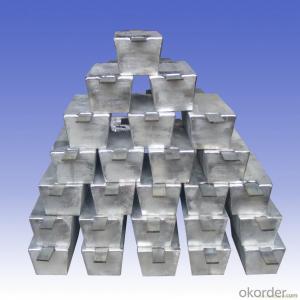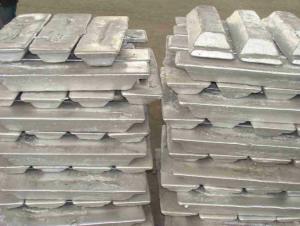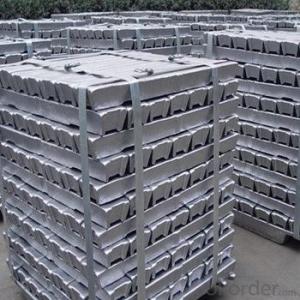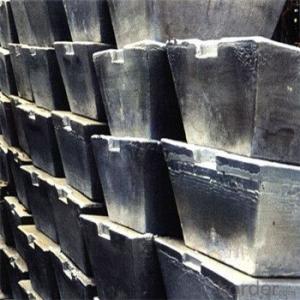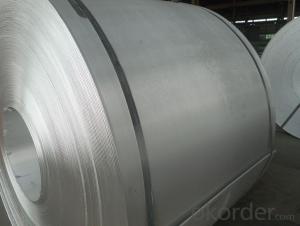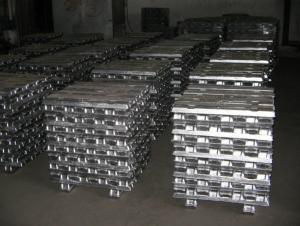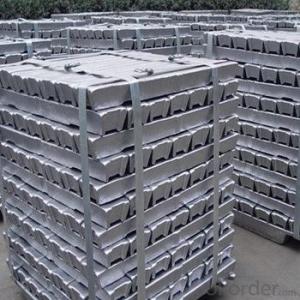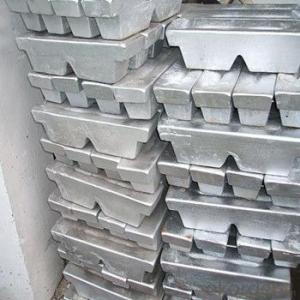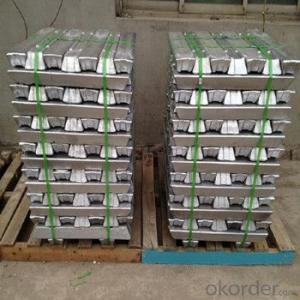Aluminium Ingot Pure 99.7% With High Quality National Standard
- Loading Port:
- China main port
- Payment Terms:
- TT OR LC
- Min Order Qty:
- 1000 m.t.
- Supply Capability:
- 10000 m.t./month
OKorder Service Pledge
OKorder Financial Service
You Might Also Like
Pure Aluminum Ingot Used for Industry
1.Structure of Aluminum Ingot Description
A material that has been cast into a shape in order to be transported and processed easier than in an unprocessed form. An ingot is typically rectangular in shape, which allows it to be stacked. Ingots are most commonly associated with metals, with ingots of gold held in the vaults of banks and brokerages being popular images.
.
2.Main Features of the Aluminum Ingot
•High Purity
•Easy operation
•High strength
•Fast melting
•Competitive price
•Best Service
3. Aluminum Ingot Images


4. Aluminum Ingot Specification
Grade | Chemical Composition % | |||||||||
Al≥ | impurities ≤ | |||||||||
Si | Fe | Cu | Ga | Mg | Zn | Mn | others | Sum | ||
Al99.9 | 99.90 | 0.50 | 0.07 | 0.005 | 0.02 | 0.01 | 0.025 | - | 0.010 | 0.10 |
Al99.85 | 99.85 | 0.80 | 0.12 | 0.005 | 0.03 | 0.02 | 0.030 | - | 0.015 | 0.15 |
Al99.7 | 99.70 | 0.10 | 0.20 | 0.010 | 0.03 | 0.02 | 0.030 | - | 0.030 | 0.30 |
Al99.6 | 99.60 | 0.16 | 0.25 | 0.010 | 0.03 | 0.03 | 0.030 | - | 0.030 | 0.40 |
Al99.5 | 99.50 | 0.22 | 0.30 | 0.020 | 0.03 | 0.05 | 0.050 | - | 0.030 | 0.50 |
Al99.00 | 99.00 | 0.42 | 0.50 | 0.020 | 0.03 | 0.05 | 0.050 | - | 0.050 | 1.00 |
5.FAQ of Aluminum Ingot
We have organized several common questions for our clients,may help you sincerely:
①How about your company?
A world class manufacturer & supplier of castings forging in carbon steel and alloy steel,is one of the large-scale professional investment casting production bases in China,consisting of both casting foundry forging and machining factory. Annually more than 8000 tons Precision casting and forging parts are exported to markets in Europe,America and Japan. OEM casting and forging service available according to customer’s requirements.
②How to guarantee the quality of the products?
We have established the international advanced quality management system,every link from raw material to final product we have strict quality test;We resolutely put an end to unqualified products flowing into the market. At the same time, we will provide necessary follow-up service assurance.
③How long can we receive the product after purchase?
In the purchase of product within three working days, We will arrange the factory delivery as soon as possible. The pecific time of receiving is related to the state and position of customers.Commonly 7 to 10 working days can be served.
- Q:What kind of aluminum consumption does the furnace compare with natural gas?
- The aluminum loss of the reverberatory furnace is proportional to the melting time: the longer the loss is, the higher the temperature of the flame, the aluminum surface continues to oxidize to alumina powder.
- Q:How are aluminum ingots used in the production of sports equipment?
- Aluminum ingots are widely used in the production of sports equipment due to their lightweight, durable, and corrosion-resistant properties. These ingots serve as the primary material for various sports equipment, including baseball bats, tennis rackets, golf clubs, and bicycles. In the manufacturing process, aluminum ingots are melted and then poured into molds to create the desired shape and size of the sports equipment. The molten aluminum is then cooled and solidified, resulting in a strong and solid structure. One of the main advantages of using aluminum ingots is their lightweight nature. This property makes the sports equipment easier to handle and maneuver, allowing athletes to exert less effort during play. For example, aluminum baseball bats are renowned for their lightweight construction, enabling players to swing the bat with greater speed and accuracy. Furthermore, aluminum ingots offer excellent durability, ensuring a longer lifespan for the sports equipment. They are known for their resistance to wear and tear, making them ideal for intense sports activities. For instance, aluminum tennis rackets can withstand the high impact of tennis balls and maintain their shape and performance over a prolonged period. Additionally, aluminum ingots possess exceptional corrosion resistance. This property is beneficial for sports equipment that is exposed to various environmental conditions, such as bicycles. Aluminum bicycle frames made from ingots are resistant to rust and corrosion, providing a longer lifespan and enhanced performance. In conclusion, aluminum ingots play a crucial role in the production of sports equipment. With their lightweight, durable, and corrosion-resistant properties, they contribute to the creation of high-quality and high-performance sports gear, enabling athletes to excel in their respective sports.
- Q:What are the properties of aluminum ingots that make them suitable for construction?
- Aluminum ingots possess several properties that make them highly suitable for construction purposes. Firstly, aluminum is a lightweight material, weighing approximately one-third of the weight of steel. This characteristic makes it easier and more cost-effective to transport and handle during construction projects. Despite its lightweight nature, aluminum is also remarkably strong, offering a high strength-to-weight ratio. This property allows for the construction of sturdy and durable structures, capable of withstanding various loads and environmental conditions. Another significant property of aluminum ingots is their excellent corrosion resistance. Aluminum forms a natural oxide layer on its surface, which acts as a protective barrier against moisture, chemicals, and other corrosive elements. This resistance to corrosion ensures that aluminum structures remain intact and maintain their structural integrity over extended periods. Aluminum ingots are also known for their malleability and ductility. These properties make it easy to shape and mold the material into various forms and designs, enabling architects and engineers to create intricate and aesthetically pleasing structures. Additionally, aluminum can be easily fabricated, welded, and joined, allowing for flexibility in construction techniques and facilitating efficient installation processes. Furthermore, aluminum is a highly sustainable material. It is 100% recyclable without losing its inherent properties. This recyclability not only reduces the environmental impact of construction projects but also contributes to cost savings and resource conservation. Lastly, aluminum ingots have excellent thermal and electrical conductivity. This feature makes aluminum an ideal choice for construction projects that require efficient heat transfer, such as in heating, ventilation, and air conditioning systems, or electrical conductivity, as in wiring and electrical components. In conclusion, the properties of aluminum ingots, including their lightweight, strength, corrosion resistance, malleability, recyclability, and conductivity, make them highly suitable for construction. These properties contribute to the creation of durable, aesthetically pleasing, and environmentally friendly structures.
- Q:102 non-standard aluminum ingot is like? And ordinary non-standard aluminum ingot what is the difference?
- Ordinary non-standard aluminum ingot is the tube you use, regardless of your standard, with miscellaneous aluminum recovery smelting out of the aluminum ingot.
- Q:How much capital do I need to invest in the recycled aluminium ingot?
- This mainly depends on how much money you scale, there are local to not to do this, I am here in Foshan now, we're not here to make this move to distant places to engage in equipment, don't need how much, I have many friends in this, but now we're not here to do
- Q:What are the different casting methods used for aluminum ingots?
- There are various casting methods commonly utilized in the production of aluminum ingots. These methods encompass: 1. Utilizing Permanent Mold Casting: This technique involves the use of an iron or steel permanent mold to shape the molten aluminum into ingots. The mold is preheated and coated with a release agent to prevent sticking. The molten metal is then poured into the mold, left to solidify, and subsequently, the mold is opened to extract the ingot. 2. Employing Continuous Casting: This method necessitates pouring the molten aluminum into a water-cooled mold that possesses a continuous cavity. As the metal solidifies, it is constantly drawn out of the mold, resulting in a continuous strand of aluminum ingots. This approach is frequently employed for the production of substantial quantities of ingots with consistent shapes. 3. Implementing Sand Casting: Sand casting is a widely employed technique for casting aluminum ingots. A sand pattern of the desired ingot shape is created, and then the mold is formed by packing sand around the pattern. The molten aluminum is poured into the mold and allowed to cool and solidify. Once solid, the sand mold is broken apart to reveal the ingot. 4. Utilizing Die Casting: Die casting is a method commonly used to produce small to medium-sized aluminum ingots with intricate details. In this process, a steel mold, known as a die, is employed. The molten aluminum is forced into the die at high pressure and rapidly cooled to solidify. The die is then opened, and the ingot is ejected. 5. Employing Centrifugal Casting: In this method, the molten aluminum is poured into a rotating mold. The centrifugal force causes the metal to spread out and solidify against the mold walls, resulting in a cylindrical ingot. This approach is particularly beneficial for manufacturing hollow or tubular ingots. Each casting method possesses its own set of advantages and disadvantages, and the selection of the method depends on factors such as the desired ingot shape, size, quantity, and specific application requirements.
- Q:The main raw material for aluminum smelting aluminum ingots from which into
- In our country the scrap aluminum recycling, about 1/5 from the packaging industry, the transportation industry from 2/5, 1/3 from the construction industry, recycling scrap cars produce scrap aluminum and aluminum cans are two important fields. China is the world's largest aluminum production and consumption country, with a large number of aluminum products into scrap, scrap recycling domestic future volume will continue to increase, and our dependence on imported scrap will also continue to reduce.
- Q:What is the average weight of an aluminum ingot?
- The average weight of an aluminum ingot can vary depending on its size and shape. However, a commonly used standard weight for an aluminum ingot is around 22.7 kilograms or 50 pounds. This weight is often used in the industry for ease of measurement and transportation. It's important to note that the actual weight of an aluminum ingot can vary slightly due to factors such as impurities or variations in the manufacturing process.
- Q:How are aluminum ingots used in the production of electrical enclosures?
- Aluminum ingots are used in the production of electrical enclosures as they are melted down and cast into specific shapes and sizes to create the main body of the enclosure. The ingots provide the necessary raw material for the enclosure's construction, offering strength, durability, and corrosion resistance. Additionally, aluminum ingots can be easily formed, machined, and welded, allowing for the creation of intricate designs and precise dimensions required for electrical enclosures.
- Q:How can the sustainability practices in aluminum ingot production be enhanced?
- There are multiple ways to enhance sustainability practices in the production of aluminum ingots. To begin with, the environmental impact of the production process can be significantly reduced by adopting cleaner and more energy-efficient technologies. This could involve utilizing renewable energy sources like solar or wind power to operate the production facilities. Upgrading equipment and machinery to more energy-efficient models can also help lower energy consumption and minimize greenhouse gas emissions. Another effective approach is to optimize the recycling and reuse of aluminum scrap and waste materials. This can greatly reduce the need for producing new aluminum. By implementing efficient recycling programs and investing in advanced recycling technologies, a higher percentage of aluminum can be recovered from end-of-life products and reintroduced into the production process. This not only conserves valuable resources but also reduces the energy-intensive extraction and refining processes associated with primary aluminum production. Improving water management practices is also crucial for enhancing sustainability in aluminum ingot production. Implementing measures such as recycling and reusing water within the production process can help minimize water consumption. Additionally, installing wastewater treatment systems to remove pollutants and contaminants from discharged water can prevent water pollution and protect local ecosystems. Furthermore, sustainability in aluminum production can be enhanced by promoting transparency and responsible sourcing practices in the supply chain. This involves ensuring that raw materials like bauxite and alumina are obtained from responsible and sustainable mining practices. Implementing traceability systems and certification programs can help verify the origin and sustainability of these materials, ensuring compliance with ethical and environmental standards. Lastly, engaging with various stakeholders, including employees, local communities, and industry associations, is essential for fostering a culture of sustainability and driving continuous improvement in aluminum ingot production. This can be achieved through regular training and awareness programs on sustainable practices, as well as collaborating with suppliers and customers to identify and implement innovative sustainability solutions. Overall, enhancing sustainability practices in aluminum ingot production requires a comprehensive approach that encompasses technological advancements, efficient resource management, responsible sourcing, and stakeholder engagement. By implementing these measures, the aluminum industry can reduce its environmental impact and contribute to a more sustainable future.
1. Manufacturer Overview |
|
|---|---|
| Location | |
| Year Established | |
| Annual Output Value | |
| Main Markets | |
| Company Certifications | |
2. Manufacturer Certificates |
|
|---|---|
| a) Certification Name | |
| Range | |
| Reference | |
| Validity Period | |
3. Manufacturer Capability |
|
|---|---|
| a)Trade Capacity | |
| Nearest Port | |
| Export Percentage | |
| No.of Employees in Trade Department | |
| Language Spoken: | |
| b)Factory Information | |
| Factory Size: | |
| No. of Production Lines | |
| Contract Manufacturing | |
| Product Price Range | |
Send your message to us
Aluminium Ingot Pure 99.7% With High Quality National Standard
- Loading Port:
- China main port
- Payment Terms:
- TT OR LC
- Min Order Qty:
- 1000 m.t.
- Supply Capability:
- 10000 m.t./month
OKorder Service Pledge
OKorder Financial Service
Similar products
New products
Hot products
Hot Searches
Related keywords
